
Broad River Energy Center
Owned and operated by Onward Energy
865 MW, dual-fuel facility in Gaffney, SC, with five 7FA.03 simple-cycle units, each equipped with an IST once-through steam generator
Plant manager: Malcolm Hubbard
Challenge. Broad River Energy Center is a dual-fuel gas-turbine facility. Reliability when starting on distillate, or switching to it from gas, was historically lower than expected. The root cause for many of the reliability issues was contamination of oil in the plant’s 4-million-gal storage tank.
Plants monitoring the condition of their backup fuel sometimes are surprised by the poor quality of oil at the bottom of their tanks—say the last 5 ft or so. This generally is not problematic given the floating suction systems typically in use today—that is, until you have to burn the dregs. It doesn’t take much sludge-type material to cause a failure to start or to trip a high-performance gas turbine. The financial penalties could be significant.
Solution. The first step to a solution was to take grab samples and have a certified lab analyze the fuel to identify the reasons for the trips, fired shutdowns, and failed transfers. Evidence in hand, a complete inspection and recommissioning of turbine fuel-system components—including flow dividers, purge valves, check valves—was conducted. A strategy to install a filtration system was developed to maintain the fuel in ready-for-service condition.
The filtration skid was installed in the fuel-oil offload area and equipped to take suction from the tank’s sump area and from its floating suction strainer. Filtered oil is returned to the top of the tank to maximize agitation and turnover of the oil.
The filtration system selected, from C C Jensen, is similar to that used in lube oil systems at many powerplants. In the first four weeks of operation more than 340 lb of contaminants was removed. Note that a vacuum truck was used to remove settled contaminants from the system before commissioning the filtration system.
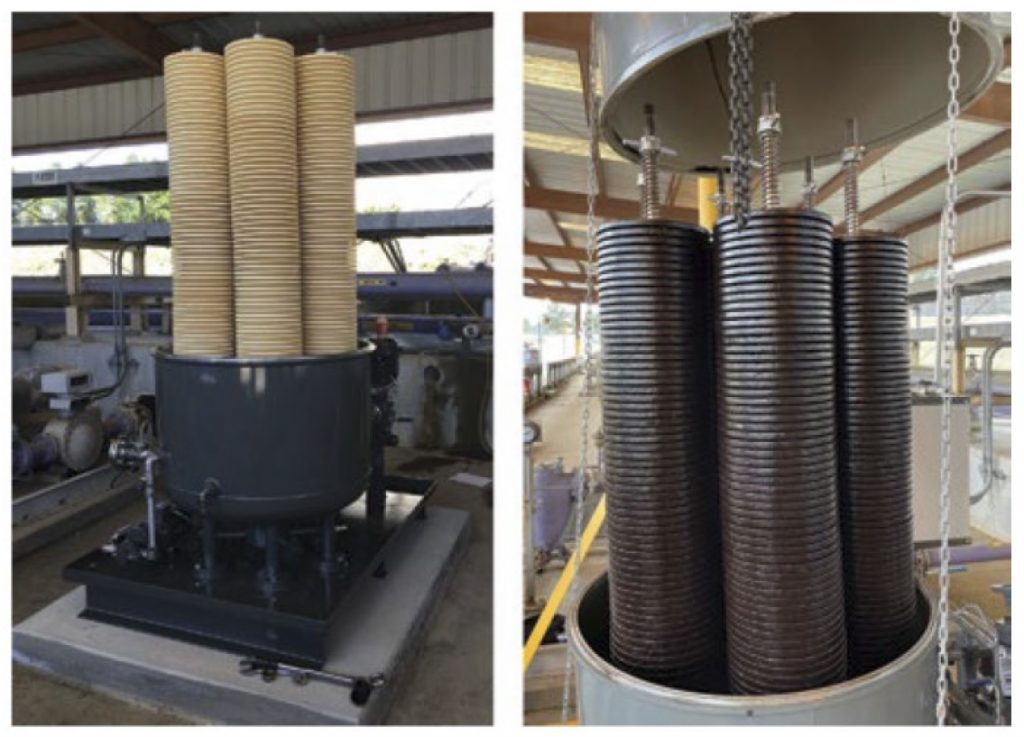
Water removed in the second stage of the two-stage filtration system is discharged directly to the oily water separator sump. A differential-pressure gage enables plant personnel to monitor the condition of the filter elements and proactively plan for filter changes.
Results. The system is meeting expectations. No hard numbers on starting reliability improvement were available prior to publication.
Project participants:
Joel McLain
Travis Haynes
Eddie Mustin
Scott Bostwick
Broad River’s 2023 Best Practices
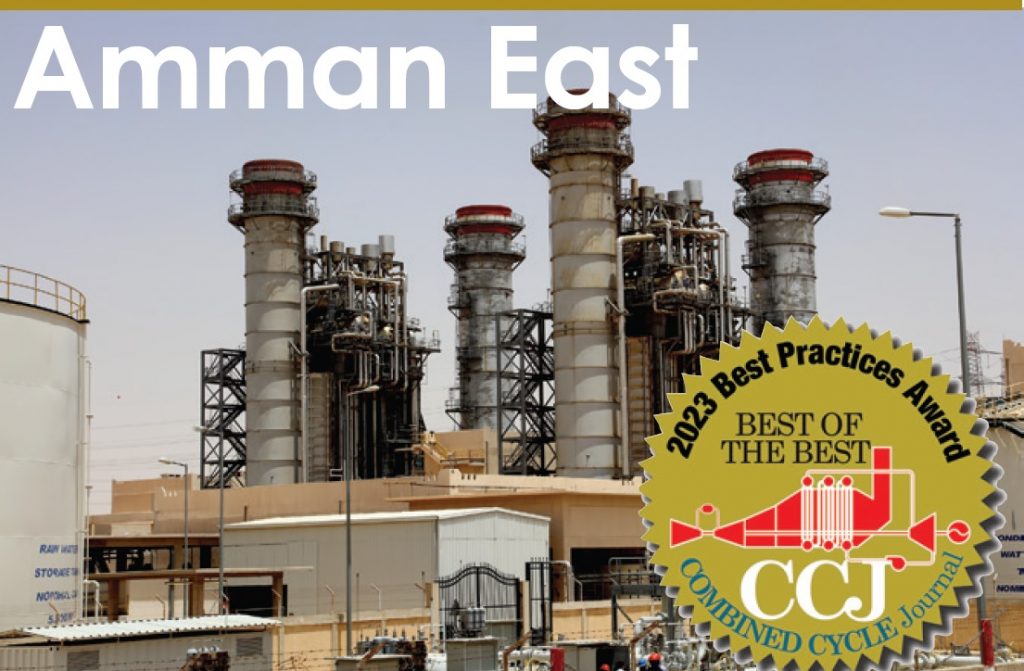
Amman East Power Plant
Owned by AES Corp, Mitsui, and Nebras Power
Operated by AES Jordan PSC400 MW, gas-fired with diesel-oil backup, 2 × 1 combined cycle powered by AE94.2 gas turbines, located in Al Manakher, Jordan. COD was September 2009
Plant manager: Feras Hammad
Background. Amman East’s gas turbines are each connected to a dedicated heat-recovery steam generator through a diverter damper, allowing the plant to run simple- or combined-cycle. Steam produced by the HRSGs drives a single-casing, condensing, non-reheat turbine. The steam cycle is dual pressure.
Challenge. LP evaporator sections in both HRSGs suffered from flow-accelerated corrosion (Fig 1). Investigations undertaken with the goal of preventing FAC or minimizing its consequences on plant productivity were not fruitful and management opted to replace the affected heat-transfer surface (Fig 2).
Solution. Each LP evaporator consists of three sections connected in parallel; each section has two harps. The harps weigh a nominal 28 t and measure approximately 21 × 4 × 0.4 m deep. The harp-replacement project began in 2021. The new modules are made with SA213-T11 tubes and SA335-P11 headers to minimize the possibility of FAC attack one might expect with carbon steel.
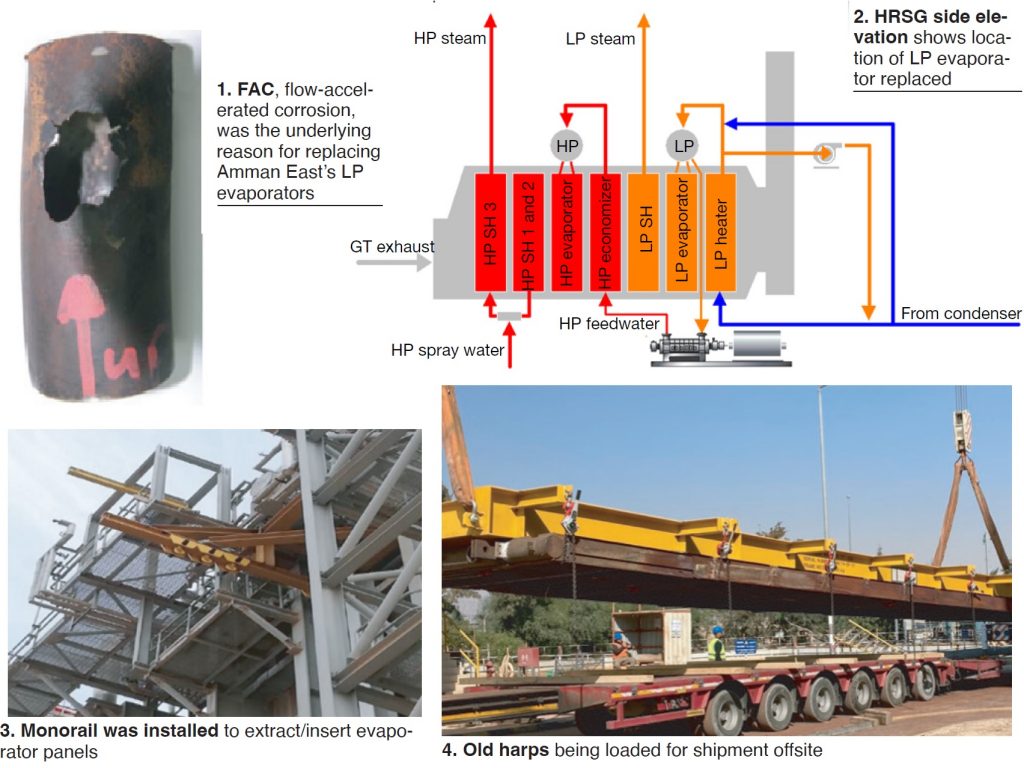
Preparation for replacement included removing a portion of the casing and installing the monorail shown in Fig 3 to extract the old panels and insert the new ones. While this work was ongoing, the new panels were transported to the site and stacked in the order they would be picked by the crane. The damaged panels were trucked offsite (Fig 4).
Final steps included installing the new harps and interconnection piping, non-destructive testing, leak testing, and flushing. Next, the HRSG casing was reinstalled with new insulation and high-temperature piping was insulated. Touch-up painting and verification that I&C and electrical circuits were properly installed brought the project to a conclusion.
Results. Rehabilitation of each HRSG took about 30 days. All project goals were achieved. Access the project’s 5-min time-lapse video produced by AlRiachi here; the editors give it two thumbs up.
Project participants:
Feras Hammad, plant manager
Sameer Ghanim, mechanical leader
Mohammad Thaher
Mohammad AlRiachi
Anas Diab, performance manager
Amman East’s 2023 Best Practices Submittals
- FAC encourages replacement of LP evaporator
- Admin building HVAC operational improvement
- Overhead-crane lift safer with load display
- ACC washing system changes promote safer operation, improved performance


Amman East Power Plant
Owned by AES Corp, Mitsui, and Nebras Power
Operated by AES Jordan PSC400 MW, gas-fired with diesel-oil backup, 2 × 1 combined cycle powered by AE94.2 gas turbines, located in Al Manakher, Jordan. COD was September 2009
Plant manager: Feras Hammad
Challenge. The climate-control system serving Amman East’s administration building was not meeting expectations. There were many complaints by employees related to the failure to maintain building temperatures within desired ranges. Plus, noise on the top floor of the building was deemed excessive.
Solution. Divide the building into four zones for better temperature control (Fig 5). Install VFDs on air-handling motors.
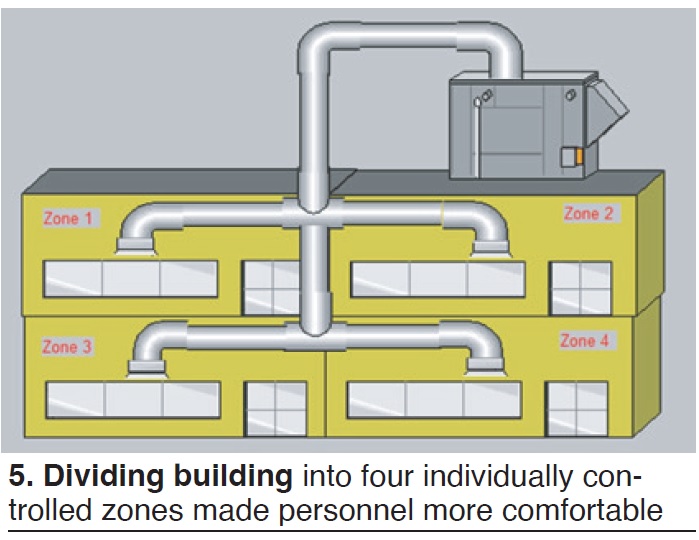
Results. Goals achieved: easy and effective control of each zone by building inhabitants, eliminated the need for operators to deviate from their important duties to change the temperature setting, better working environment, less wear and tear on HVAC equipment, etc.
Project participants:
Sameer Ghanim, mechanical leader
Mohammad Yacoub, maintenance manager
Mohammad Al Ziq, I&E leader
Amman East’s 2023 Best Practices Submittals
- FAC encourages replacement of LP evaporator
- Admin building HVAC operational improvement
- Overhead-crane lift safer with load display
- ACC washing system changes promote safer operation, improved performance


Amman East Power Plant
Owned by AES Corp, Mitsui, and Nebras Power
Operated by AES Jordan PSC400 MW, gas-fired with diesel-oil backup, 2 × 1 combined cycle powered by AE94.2 gas turbines, located in Al Manakher, Jordan. COD was September 2009
Plant manager: Feras Hammad
Challenge. Lift safety benefits from having the crane operator able to verify that load on his hook is known and free in all directions. In some cases, however, the object being lifted may have hidden corners or be of an unconfirmed weight, increasing the level of lift risk and possibly creating some operator discomfort.
Solution. Install a load display (Fig 6) to eliminate a possible unknown and improve the probability of lift success.
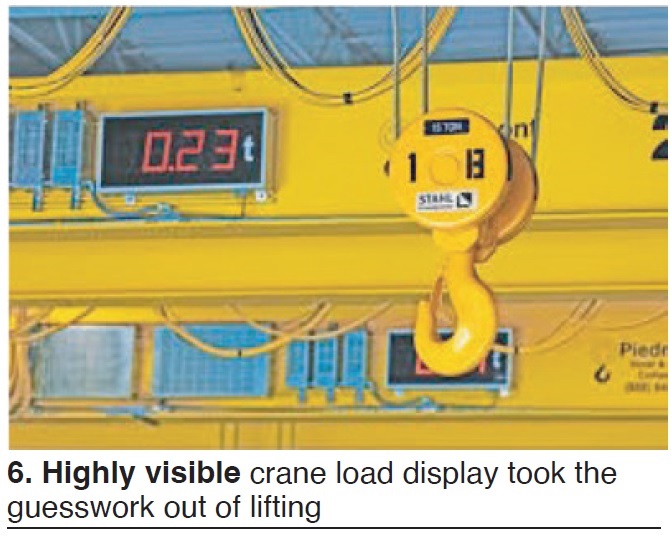
Results. The load display provides the crane operator the information he or she needs to make a safe lift.
Project participants:
Sameer Ghanim, mechanical leader
Mohammad Yacoub, maintenance manager
Mohammad Al Ziq, I&E leader
Amman East’s 2023 Best Practices Submittals
- FAC encourages replacement of LP evaporator
- Admin building HVAC operational improvement
- Overhead-crane lift safer with load display
- ACC washing system changes promote safer operation, improved performance


Amman East Power Plant
Owned by AES Corp, Mitsui, and Nebras Power
Operated by AES Jordan PSC400 MW, gas-fired with diesel-oil backup, 2 × 1 combined cycle powered by AE94.2 gas turbines, located in Al Manakher, Jordan. COD was September 2009
Plant manager: Feras Hammad
Challenge. The washing system for cleaning Amman East’s air-cooled condenser created high noise and vibration when operating—at times so severe that the discharge line would break.
Solution. These proposed solutions were investigated by plant personnel:
- Shifting the washing pump skid to the nearest adequate source.
- Changing the suction line to stainless steel and increasing its diameter.
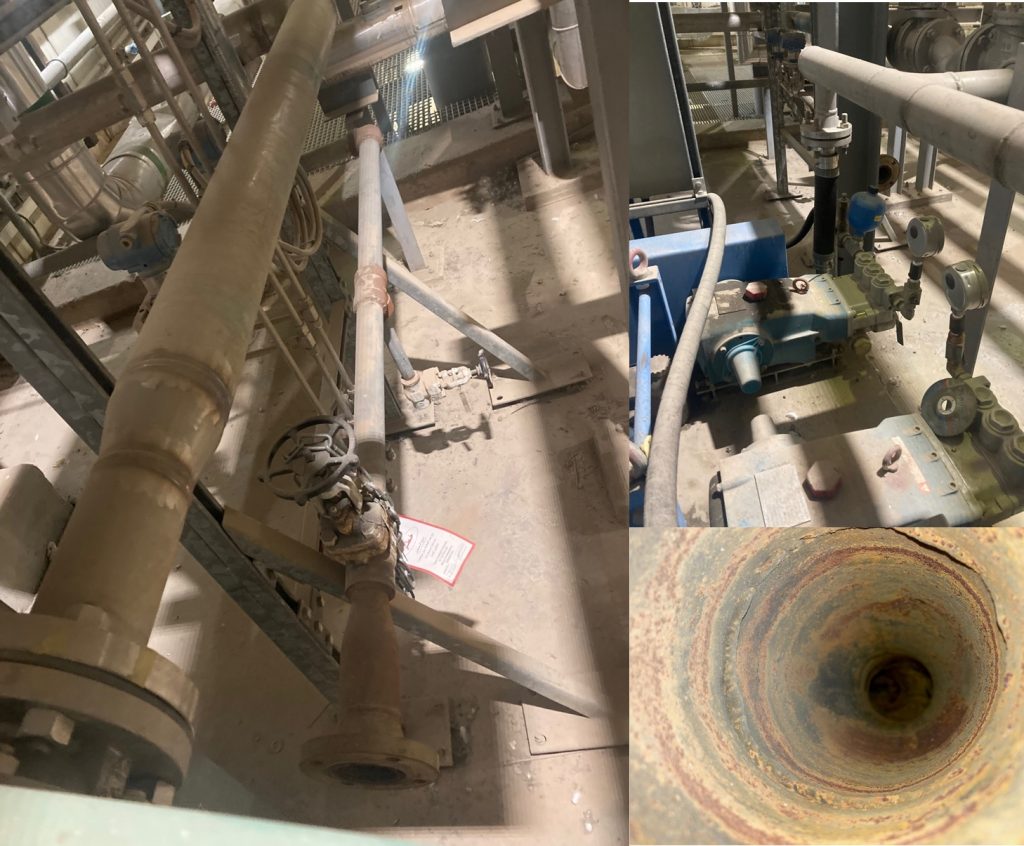
Results. Problems solved: Cleaning performance improved, noise level reduced, repairs previously required eliminated.
Project participants:
Hussain Al-ajarmi
Ali Hamed
Amman East’s 2023 Best Practices Submittals
- FAC encourages replacement of LP evaporator
- Admin building HVAC operational improvement
- Overhead-crane lift safer with load display
- ACC washing system changes promote safer operation, improved performance


River Road Generating Plant
Owned by Clark Public Utilities
Operated by GE Vernova248 MW, gas-fired 1 × 1 7FA.02-powered combined cycle equipped with a Foster Wheeler HRSG, and a GE A12 steam turbine, located in Vancouver, Wash
Plant manager: Robert Mash
Challenge. The HRSG high-pressure drum doors had a history of leaking. Some leaks caused forced outages; all leaks represented safety hazards for employees.
During annual outages, the drum doors were a challenge to close and seat properly for several reasons, including these:
- Bent and worn drum-door hinge hardware, which often caused misalignment of the door-to-drum connection.
- Pitted drum and door seating surfaces allowed a pathway for steam to leak.
- Worn drum-door bolts and strongbacks resulted in over-tightening (over torque).
- The heavy weight of the doors required personnel to use pry bars and wood blocks to center the drum doors in the drum opening (the existing drum-door leveling blocks did not perform well).
Solution. River Road is a baseload facility with very little downtime. Thus, all remedies listed below were implemented at the same time:
- Performed “phonograph-groove” machining on drum manway and door gasket sealing surfaces (Fig 1).
- Replaced the drum-door internal hinge assemblies.
- Replaced drum-door strongbacks (Fig 2).
- Replaced drum-door bolting with Superbolt™ and nut design.
- Replaced existing drum-door leveling blocks with an improved style (Fig 3).
- Completed machining and installing all parts during a single annual outage.
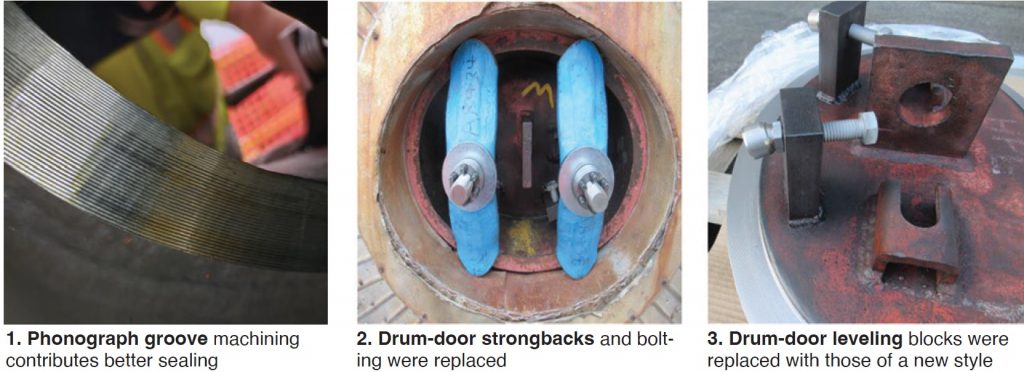
Results.
- Performed several startups and shutdowns post-outage with zero leaks to date.
- Project provided the opportunity for team participation and collaboration to identify all related issues and research potential solutions.
- The new drum-door leveling system works perfectly.
- The Superbolt and nut system ensures proper torque is applied to drum doors and can be accomplished with a small ratchet torque wrench.
- Enhanced safety was achieved for all personnel working near or passing through the vicinity of the drum doors.
- The physical effort and time required for opening and closing drum doors was reduced significantly.
Project participants:
Ken Roach, maintenance manager
Mike Buhman, mechanic
River Road’s 2023 Best Practices

River Road Generating Plant
Owned by Clark Public Utilities
Operated by GE Vernova248 MW, gas-fired 1 × 1 7FA.02-powered combined cycle equipped with a Foster Wheeler HRSG, and a GE A12 steam turbine, located in Vancouver, Wash
Plant manager: Robert Mash
Challenge. River Road has a GE A12 steam turbine with 21 sets of diaphragms. During major inspections, handling all 42 diaphragm halves safely requires a lot of time—particularly when they are loaded onto pallets (Fig 4). In order to complete inspections, sandblasting, and repairs, each diaphragm must be handled several times when loaded on pallets.
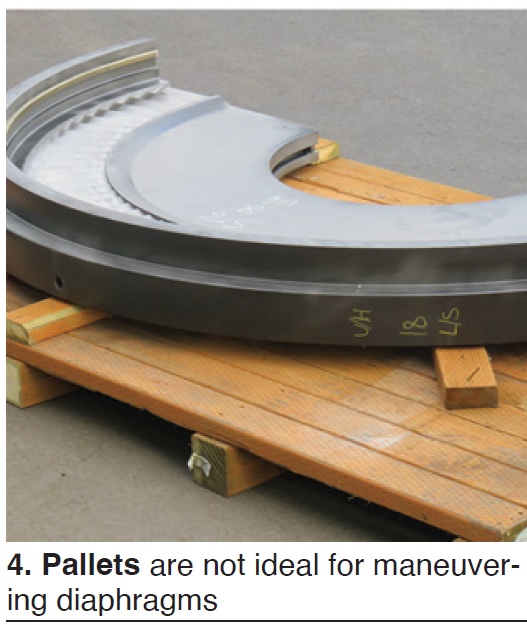
Solution. Construct steel diaphragm racks that can hold multiple stages (Fig 5).
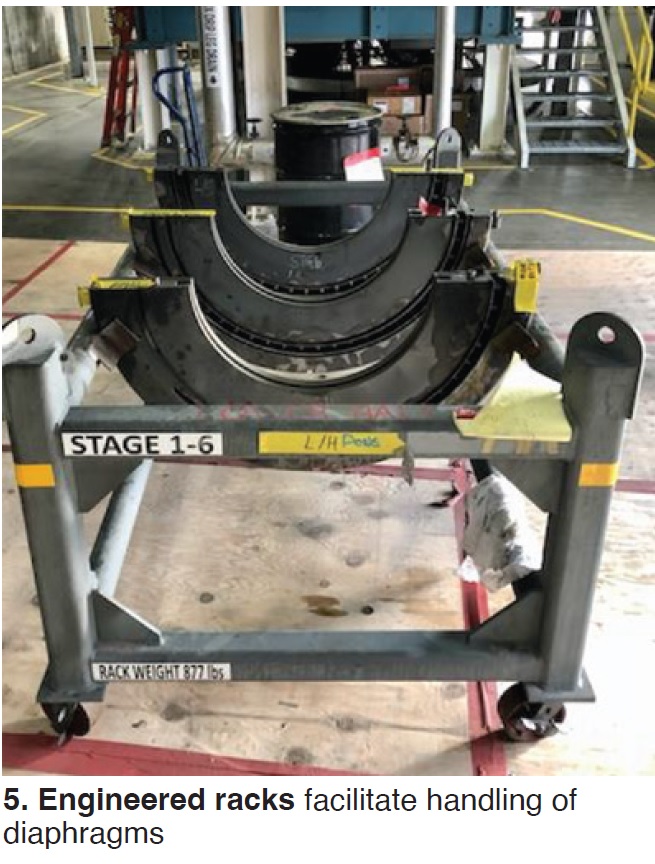
All diaphragm weights and sizes were confirmed by a steam-turbine engineer to ensure the racks have adequate structural strength and provide adequate diaphragm support. For safety, ease of handling, and identification, each rack has the following:
- ID labels indicating which diaphragms are to be held in each rack.
- Maximum allowable weight label for each loaded rack.
- Empty weight label on the rack when unloaded.
- Lifting eyes for rack movement by crane.
- Heavy-duty wheels on each rack for ease of movement with a forklift.
- Mounted keeper tabs to secure each section of the diaphragm in place during rack movement.
- Reflective tape on racks for safe movement during low-light operations.
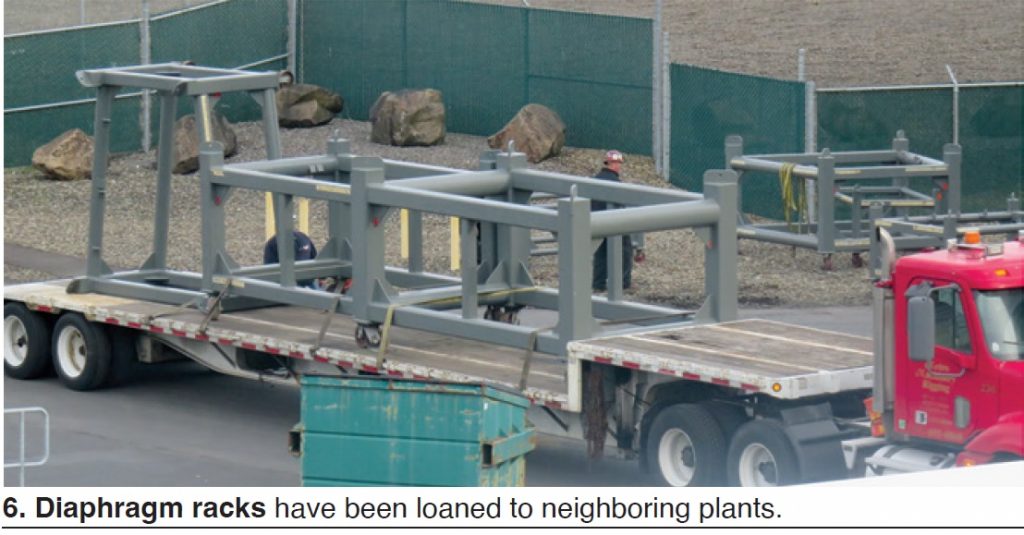
Results. Construction of the diaphragm racks has resulted in several positive results, including the following:
- Time savings
- Racks can be transported to the turbine deck during diaphragm removal.
- Multiple diaphragms can be loaded onto a rack quickly once removed from the turbine casing.
- Bridge-crane time is reduced.
- Diaphragms can be inspected easily on the racks.
- Minor repairs can be made to a diaphragm when it is on the rack.
- Sandblasting can be done on the racks.
- Handling and transport
- Both sides of the diaphragm can be seen and serviced while on the rack.
- Large caster wheels installed on the racks facilitate their movement. Small racks can be manually pushed to new locations; larger racks can be moved using forklifts.
- The results have been so beneficial that other plants have borrowed the racks for use during their outages (Fig 6).
Project participants:
The entire plant staff
River Road’s 2023 Best Practices

River Road Generating Plant
Owned by Clark Public Utilities
Operated by GE Vernova248 MW, gas-fired 1 × 1 7FA.02-powered combined cycle equipped with a Foster Wheeler HRSG, and a GE A12 steam turbine, located in Vancouver, Wash
Plant manager: Robert Mash
Challenge. River Road relies on a twin, double-pass reverse-osmosis system to provide ultrapure water for HRSG makeup, gas-turbine water wash, and the hydrogen generator. Over time, the operators most familiar with operating and maintaining the RO units have moved on. Only one outside operator remained who had been trained and certified in RO O&M.
Solution. The operations manager recognized the value the one certified operator brought to the table and decided to expand the knowledge base of the whole team. All operators attended a Reverse Osmosis Specialist Certification Course.
Results. The site now has a full team of certified operators who provide system knowledge and take ownership of it. The additional training has increased reliability and efficiency: The operations team is now able to quickly identify potential issues before they have a negative impact on plant operations.
Project participants:
Jake Sanderson, Micah Wild, Mark Todd, Allen Barnes, and Jesse Robinson are now certified in RO O&M.
River Road’s 2023 Best Practices

River Road Generating Plant
Owned by Clark Public Utilities
Operated by GE Vernova248 MW, gas-fired 1 × 1 7FA.02-powered combined cycle equipped with a Foster Wheeler HRSG, and a GE A12 steam turbine, located in Vancouver, Wash
Plant manager: Robert Mash
Challenge. Proper staffing is a core requirement for a well-functioning powerplant. Filling a vacant position with the right person is very time-consuming. Additions to the team, even members with years of industry experience, require several months of training to acquire competency in site-specific policies, procedures, regulations, and system operation.
When a position opens, there is an immediate staffing shortage until the lengthy hiring process is complete. This increases the need for overtime and places an additional burden on the remaining operators as they work to cover shifts.
Promoting personnel internally provides opportunities for advancement.
Solution. River Road created a new position to help reduce staffing shortages: “Operator in Training,” a/k/a OIT, a full-time entry-level job. This position allows the plant to hire local personnel who have potential but minimal power-industry experience. It provides an opportunity for the OIT to move to the next available operator position.
River Road’s OIT program is comprised of the following three parts:
- Employee orientation introduces the new hire to plant administration and corporate and site policies.
- EHS training and restricted work authorization is designed to familiarize the employee with all hazards present at the facility and how to safely work with them. The training also introduces the employee to all environmental, health, and safety practices at the facility. Successful completion of this part of the OIT program allows the employee to work and navigate the facility unattended.
- System qualification program. The final section of the program provides a basic understanding of plant equipment, systems, and shift routines. This includes gas turbine, steam turbine, HRSG, water chemistry, thermodynamics, and balance-of-plant fundamentals.
After completing Parts A, B, and C, the trainee is required to successfully complete both written and oral exams. After passing the OIT qualification program, the operator can begin training for the next level: “Outside Operator Qualification Program.” Depending on the individual, the OIT program takes approximately one year to complete.
Results. Because the position is entry-level, there is a large pool of candidates to choose from. The candidates may have talent and aptitude, but lack industry experience.
Employees in the OIT program are often nearly qualified to stand watch when the next advancement opportunity arises. Staffing shortages during these periods have been greatly reduced. Since beginning the program, several OITs have advanced to outside operators.
In sum, the qualified OIT program provides the following:
- A staffing buffer.
- An operator-ready team member familiar with the plant.
- The ability to hire locally.
- The ability to train a new person from the start and introduce the OIT to the plant’s culture.
Project participants:
Justin Hartsoch, operations manager
Robert Brown, shift supervisor
Steve Ellsworth, shift supervisor
River Road’s 2023 Best Practices
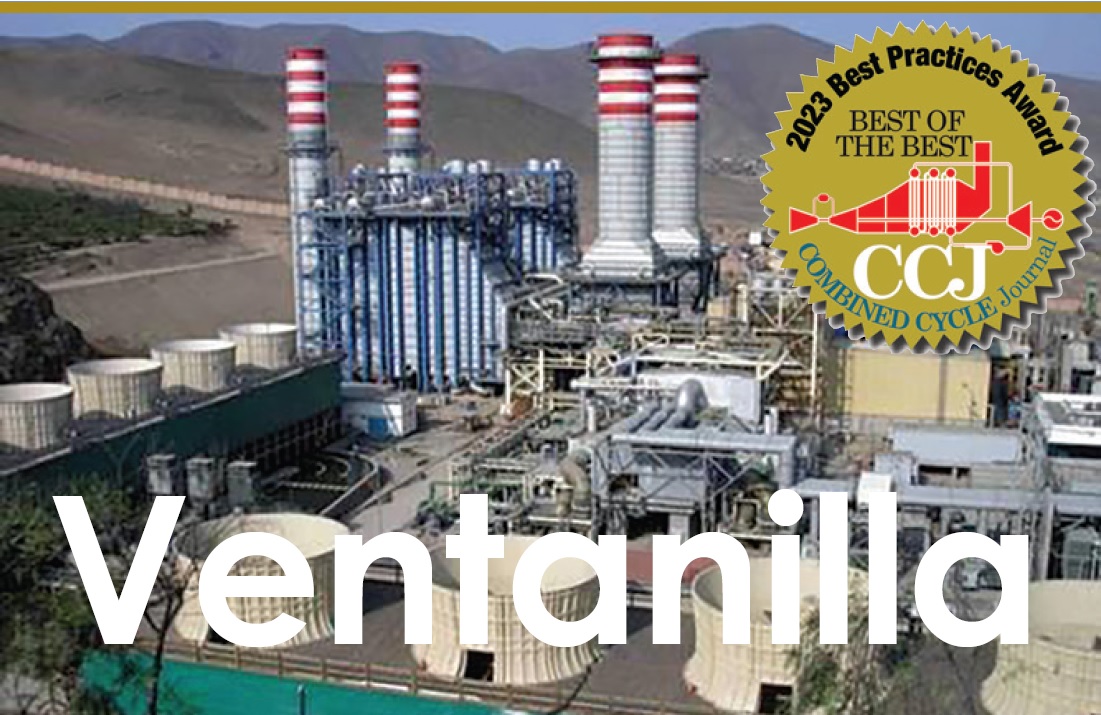
Ventanilla Combined Cycle Power Plant
Owned and operated by ENEL Generacíon Perú
427 MW, 2 × 1 SGT6-4000F-powered dual-fuel powerplant, located in Callao, Perú
Plant manager: Dany Alcantara
Plant background. Endesa SA, Spain’s largest electric utility, won a tender in December 1995 to take control of Empresa de Generación Termoeléctrica de Ventanilla (Etevensa), the genco operating the Ventanilla thermal plant in Perú’s Callao Province, Lima Region. Etevensa had been spun off from Electroperu SA.
Endesa was the lead company in Consorcio Generalima, which also included two Peruvian companies. According to Christopher Bergesen, a Maryland-based consultant with deep knowledge of the global electric power business, the consortium bid $US120 million and agreed to modernize the plant.
The plant was upgraded in 1997 when the OEM of record supplied and installed a pair of 170-MW gas turbines, replacing the 110-MW 501D5 engines installed in 1993.
Endesa took full control of Etevensa in August 2003 and the following year converted Ventanilla to combined-cycle operation by adding a supplementary-fired HRSG downstream of each GT and a 184-MW steam turbine.
In September 2004, Ventanilla, now owned and operated by Endesa successor company Enel Generación Perú, began burning Peruvian gas and producing power for distribution via the national grid. In January 2021, Enel commissioned a 14.6-MW battery energy storage system—Perú’s first—using lithium-ion technology.
 Challenge. Prevent the recurrence of a transformer forced outage suffered by Ventanilla a few years ago when an HV bushing failed (Fig 1).
Challenge. Prevent the recurrence of a transformer forced outage suffered by Ventanilla a few years ago when an HV bushing failed (Fig 1).
Solution investigated was the installation of an online monitoring system capable of detecting changes in critical operating data that might suggest an impending failure. The daily cost of a transformer outage at Ventanilla is about $100,000.
Investigations by plant personnel pointed to Camlin Energy’s Totus system, which is said to monitor all key components of the transformer, providing a picture of transformer health. It integrates dissolved gas analysis (DGA), partial discharge (PD), bushing monitoring (BM), through fault currents (a/k/a short-circuit currents), and transformer analytics into a single system.
The following instrumentation was installed on transformers serving the gas turbines: bushing sensor (Fig 2), load current monitor, communications mod bus TCP/IP, temperature monitor, oil leak detector, DGA, PD. Gases dissolved in the transformer oil, both analyzed and trended are hydrogen, ethylene, acetylene, CO₂, CO, ethane, methane, moisture, oxygen.
PD monitoring of transformer windings identifies amplitude, repetition rate, and PD persistence—the last to avoid a false alarm and provide reliable information. A PD-status level (scale of 1 to 10) is determined using amplitude and repetition rate.
Bushing health is tracked using tan delta and capacitance data. Leakage current from each bushing is monitored and variations in current amplitude and angle between adjacent phases calculated.
Recall that tan delta test results help gauge the condition of transformer insulation and determine how close it may be to a fault condition. There are two ways to evaluate insulation health during a tan delta test, according to information provided by Altanova, a Doble company:
- The first is to compare current results to those from previous tests, thereby determining the impact of aging on deterioration.
- The second is to determine directly insulation condition using the tan delta value. If the insulation is perfect, the loss factor will be about the same for the range of test voltages. But if the insulation is less than perfect, the tan delta value will increase as the test voltage increases.
Results. Since Ventanilla’s online monitoring program was implemented, there has not been a forced outage attributed to a transformer failure. Plus, plant personnel are more aware of the positive impact their vigilance can have on operating costs, as well as the safety benefits of avoiding a fire or explosion caused by a short circuit.
Enel project participants:
Gustavo Rodriguez, electrical specialist and project manager
Fernando Sarmiento, electrical supervisor
Eduardo Salinas, electrical supervisor
Ventanilla 2023 Best Practices
- Online monitoring alerts to transformer issues, protecting against a forced outage at Ventanilla
- HRSG deep cleaning with dry ice pellets at high pressure meets Ventanilla’s expectations
- Cooling-tower upgrade increases electric generation at Ventanilla
- Tighter control of circ-water chemistry improves economics, safety at Ventanilla


